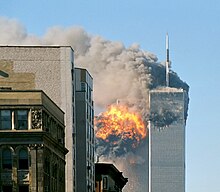Modern History New York City - kuvykin
The Great Irish Famine brought a large influx of Irish immigrants, and by 1860, one in four New Yorkers—over 200,000—had been born in Ireland.[87] There was also extensive immigration from the German provinces, where revolutions had disrupted societies, and Germans comprised another 25% of New York's population by 1860.[88]
Bird's eye view print of Manhattan & New York City, 1873. The Brooklyn Bridge was under construction from 1870 until 1883.
It deteriorated into vicious attacks on blacks and their property, following fierce competition for a decade between immigrants and blacks for work. Rioters burned the Colored Orphan Asylum to the ground, but its more than 200 children escaped harm.[88] Rioters killed an estimated 100 blacks and attacked many more, especially in the docks area. It was one of the worst incidents of civil unrest in American history.[89] Because of the violence, many blacks left the city for Williamsburg, Brooklyn and New Jersey; the black population in Manhattan fell below 10,000 by 1865, which it had last been in 1820. The white working class had established dominance.[88]
In 1898, the modern City of New York was formed with the consolidation of Brooklyn (until then a separate city), the County of New York (which then included parts of the Bronx), the County of Richmond, and the western portion of the County of Queens.[90] The opening of the subway in 1904, first built as separate private systems, helped bind the new city together. Throughout the first half of the 20th century, the city became a world center for industry, commerce, and communication. In 1904, the steamship General Slocum caught fire in the East River, killing 1,021 people on board.
In 1911, the Triangle Shirtwaist Factory fire, the city's worst industrial disaster, took the lives of 146 garment workers and spurred the growth of the International Ladies' Garment Workers' Union and major improvements in factory safety standards.[91]
New York's nonwhite population was 36,620 in 1890.[92] In the 1920s, New York City was a prime destination for African Americans during the Great Migration from the American South. By 1916, New York City was home to the largest urban African diaspora in North America. The Harlem Renaissance of literary and cultural life flourished during the era of Prohibition. The larger economic boom generated construction of competing skyscrapers that changed the skyline into its identifiable twentieth-century shape.
New York became the most populous urbanized area in the world in early 1920s, overtaking London. The metropolitan area surpassed the 10 million mark in early 1930s, becoming the first megacity in human history.[93] The difficult years of the Great Depression saw the election of reformer Fiorello LaGuardia as mayor and the fall of Tammany Hall after eighty years of political dominance.[94] Returning World War II veterans created a postwar economic boom and the development of large housing tracts in eastern Queens. New York emerged from the war unscathed as the leading city of the world, with Wall Street leading America's place as the world's dominant economic power. The United Nations Headquarters (completed in 1950) emphasized New York's political influence, and the rise of abstract expressionism in the city precipitated New York's displacement of Paris as the center of the art world.[95]
The city suffered the worst nationally of the September 11, 2001 attacks, when nearly 3,000 people died in the destruction of the twin towers of the World Trade Center.[98] A new complex, which includes One World Trade Center, a 9/11 memorial and museum, and three other office towers, is being built on the site. The first buildings are finished and it is scheduled for completion by 2014.[99] The World Trade Center PATH station, which was opened on July 19, 1909 as the Hudson Terminal, was also destroyed in the attack. A temporary station was built and opened on November 23, 2003. A permanent station, the World Trade Center Transportation Hub, is currently being constructed and is scheduled to be completed in the second quarter of 2014.[100]


No comments:
Post a Comment
Thank you for commenting. Eric Kuvykin